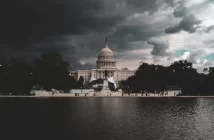By Megan Sayles
AFRO Business Writer
msayles@afro.com
Leaders of a Beautiful Struggle (LBS), a grassroots think tank in Baltimore, hosted a panel discussion on Sept. 19 to dissect a ballot question that would shrink the size of the Baltimore City Council from 14 districts to eight. The initiative, known as question H, has been spearheaded by People for Elected Accountability and Civic Engagement (PEACE), an organization led by Jovani Patterson and funded by the billionaire chairman of Sinclair Broadcast Group, David Smith.
LBS and other opponents believe the measure would usurp political power from Baltimore’s Black communities, which make up the majority of the city’s population.
 Social justice advocate Joshua Harris, left; Andy Ellis, chair of Baltimore For Democracy; Delegate Melissa R. Wells (D-40); and Senator Charles E. Sydnor (D-44) discuss question H, a ballot measure that would reduce the Baltimore City Council from 14 seats to eight. The panel took place at an event hosted by the Baltimore-based thinktank, Leaders of a Beautiful Struggle on Sept. 19. (AFRO Photo/Megan Sayles)
Social justice advocate Joshua Harris, left; Andy Ellis, chair of Baltimore For Democracy; Delegate Melissa R. Wells (D-40); and Senator Charles E. Sydnor (D-44) discuss question H, a ballot measure that would reduce the Baltimore City Council from 14 seats to eight. The panel took place at an event hosted by the Baltimore-based thinktank, Leaders of a Beautiful Struggle on Sept. 19. (AFRO Photo/Megan Sayles)
“We know that if you reduce the number of council members for Baltimore City, it will have significant impacts on representation in our communities,” said Maryland Delegate Melissa R. Wells (D-40). “When you look at the differences in educational attainment and employment or unemployment, each block varies. There are a lot of blocks and communities that have significant needs to be met.”
Baltimore has increasingly become known for the “Black Butterfly,” a metaphor coined by scholar Lawrence Brown to depict racial and economic segregation in the city. The term is used to describe the shape that appears on the map when marking areas of the city with disparities in healthcare, internet access and more. Black communities of Baltimore have faced long-standing disinvestment, greater poverty rates and limited access to resources. Several of these neighborhoods border predominantly wealthy, White neighborhoods.
Wells believes that by consolidating residents with distinct needs into larger districts, council members will not have the means to effectively serve their stakeholders.
“I’m really concerned that decreasing the number of council members that represent parts of my district in West Baltimore, which is the heart of the ‘Black Butterfly,’ is going to make it harder for those constituents to get access and for their voices to be heard,” said Wells.
One of PEACE’s arguments for the reduction of the Baltimore City Council is that larger, surrounding counties represent more people with less council members. Anne Arundel County, which serves about 590,000 residents, and Baltimore County, which maintains nearly 850,000 residents, only have seven council members.
But, Baltimore County Senator Charles E. Sydnor (D-44) explained that some residents and officials are leading initiatives to increase the size of their county council.
“We have been attempting to do just the opposite of what’s happening in Baltimore City, and that’s to actually expand our council,” said Sydnor. “Since Baltimore County was a charter county, it has had 7 elected council people. We were a part of an effort to increase it to 11 members.”
The VOTE4MORE! ballot question is set to be voted on by Baltimore County residents this November.
Andy Ellis, chair of Baltimoreans For Democracy (BFD), pointed out that while Baltimore County has less seats on its council, it also has no women and only one African American. He warned that a decrease in the Baltimore City Council could stifle diversity.
“It’s going to be more well-to-do White men and less women and less Black folks,” said Ellis. “We should take caution from what the Baltimore County Council looks like right now and make sure that we preserve our council so it can look like it does right now.”
Ellis also implied that a smaller council could give Smith greater political influence. The billionaire’s company currently owns two of the largest media outlets in the city, the Baltimore Sun and WBFF Fox45. The latter has long been known for its conservative leanings, much like the businessman.
“It’s easier to buy a council [of]eight than it is to buy a council of 14,” said Ellis.
Patterson, a frontman of question H, believes questioning the structure and effectiveness of local government is good for democracy. He said the ballot initiative is centered on ensuring that Baltimore’s government is accountable, efficient and representative of its current population.
“Larger districts with more constituents create a stronger incentive to council members to be truly engaged and responsive to a broader section of their electorate,” wrote Patterson, in an email to the AFRO. “As it stands, many of Baltimore’s council members are elected with a relatively small number of votes, which can lead to disengagement from the broader needs of the community. Our initiative is about making sure that every voice is heard, not just those in small, select districts.”
Patterson does not believe a smaller council will put racial diversity at risk. He noted that people of color already dominate the city’s government. Instead, he thinks the larger issue is the rise in departures from the city. He believes the exodus has been necessitated by the city council’s failure to address safety, education and economic challenges.
“Ultimately, this initiative is about fiscal responsibility and ensuring that Baltimore’s resources are spent on addressing the city’s actual needs—improving education, public safety, and lowering the cost of living for residents—not maintaining a bloated council structure,” wrote Patterson. “We need to challenge the status quo and ask ourselves: is the current system working for the people of Baltimore, or is it perpetuating inefficiencies that prevent the city from thriving?”
The AFRO reached out to Sinclair Broadcast Group for comment, but did not receive a response.


